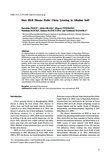Does HLB Disease Prefer Citrus Growing in Alkaline Soil?
JARQ : Japan Agricultural Research Quarterly
| ISSN | 00213551 |
|---|---|
| 書誌レコードID(総合目録DB) | AA0068709X |

本文フルテキスト
jarq54-1_21-29.pdf729.8 KB
An epidemiological investigation was conducted in the Amami Islands of Kagoshima Prefecture, Japan to determine the pathogenesis of citrus greening disease, also known as citrus Huanglongbing (HLB) disease, especially in relation to trace metal nutrition. We sampled 11 sites with acidic soil and 46 sites with alkaline soil in private gardens on the islands of Tokunoshima and Amami Oshima. At the acidic sites, no HLB-infected citrus trees were detected using PCR amplification. In the private gardens, 38.6% of the trees tested were infected with HLB disease. By comparing soil pH values in those private gardens, we found that HLB infection was related to soil pH. Among trees growing in alkaline soil, 47.8% were infected, whereas none of the trees growing in acidic soil in the private gardens were infected. When comparing a distribution map of HLB-diseased trees with a soil component map of the five Amami Islands, HLB disease was not detected in acidic soil, but the distribution of HLB-diseased trees was similar to the location of alkaline soil. Microelement analysis of leaves from trees grown in alkaline soil revealed significantly lower levels of manganese (71.9%), copper (70.1%), zinc (52.3%), and iron (40.9%) compared with the leaves from trees grown in acidic soil. These results suggest that HLB disease prefers citrus growing in alkaline soil where the concentrations of Fe and Zn nutrients are reduced.
| 刊行年月日 | |
|---|---|
| 作成者 | Haruhiko INOUE Akiko OKADA Shigeru UENOSONO Motofumi SUZUKI Tomoya MATSUYAMA4 Yoshikuni MASAOKA |
| 著者キーワード |
acidic soil citrus greening disease iron micronutrient PCR |
| 公開者 | Japan International Research Center for Agricultural Sciences |
| 受付日 | 2018-08-31 |
| 受理日 | 2019-06-25 |
| 巻 | 54 |
| 号 | 1 |
| 開始ページ | 21 |
| 終了ページ | 29 |
| DOI | 10.6090/jarq.54.21 |
| 言語 | eng |
